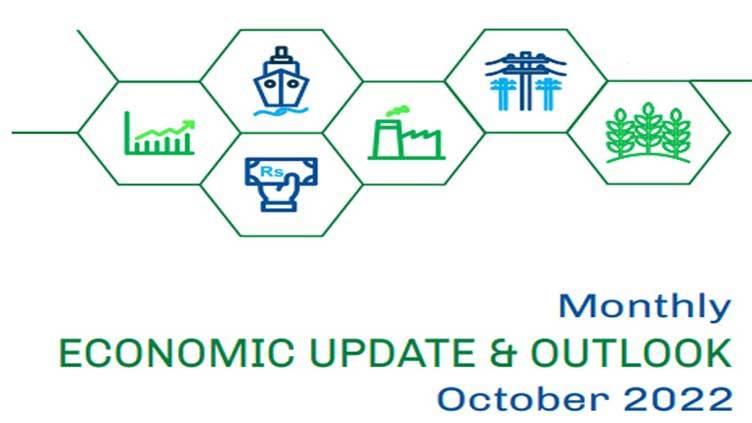The trade balance of Pakistan is expected to improve in the coming months on account of import contraction due to a deceleration in domestic economic activity and aggregate demand, the monthly Economic Update and Outlook October 2022 released by the ministry of finance said on Sunday.
"Overall economic outlook shows an optimistic picture of the economic performance in the coming months. The CPI inflation is declining, rupee has gained stability, and the current account balance is on an improving trend. These development indicate that economic activity will remain positive and persistent in coming months", the report added.
It said that for the future path of inflation, the exchange rate is of utmost importance. Moderating inflation also contributes to exchange rate stability, which in the benign case may generate a virtuous inflation-exchange rate cycle. Further, exchange rate stability requires sound economic fundamentals.
Besides inflation, a manageable current account deficit and guaranteed financing of this deficit by healthy financial inflows are also required. When markets get convinced about these prospects, speculative bubbles in the exchange market would be highly unlikely.
In the short to medium run, helped by sound domestic fiscal and monetary policies, the current account deficit is expected to reduce. A major risk factor, though, relates to the necessary imports to absorb the devastating consequences of the floods. However, downward revision of Pakistan’s main trading partners’ outlook may have a downside risk for exports in coming months.
For the fiscal sector, catastrophic floods require rehabilitation and massive expenditures, which will pose a significant challenge for fiscal consolidation. On the other hand, growth prospects have weakened, along with contained economic activities and low demand, which will impact on resource mobilization. Thus, FY2023 is moving with challenges, seeking balance policy mix for stabilization.
In the long run, sound fundamentals and a healthy growing economy, a significant raise is required in gross fixed capital formation instead on consumption. This will increase the National Income significantly. Further, there is need to enhance the productive capacity and productivity in each sector to substitute imports by domestic production and
provide more supply capacity to the foreign markets, the report added.
The report added that the provisional net tax collection in September FY2023 stood at Rs 684.8 billion against Rs 534.0 billion in the same month of last year, posting a growth of 28.2%. Thus, the first quarter of the current fiscal year ended up with a growth of 17% with a net tax collection of Rs 1633.9 billion against Rs 1396.4 billion in the comparable period of
last year. Similarly, the target for the first quarter has also been surpassed by Rs. 24.4 billion.
The fiscal deficit during July-August FY2023 has been recorded at 0.9% of GDP (Rs.672 billion) against the deficit of 0.7% of GDP (Rs.462 billion) in the same period of last year. While the primary balance posted a deficit of Rs.90
billion (-0.1% of GDP) in July-August FY2023 against the deficit of Rs 37 billion (-0.1% of GDP) in the comparable period of last year.
The Current Account posted a deficit of $ 2.2 billion for July-September FY2023 as against a deficit of $ 3.5 billion last year, mainly due to increase in exports and contraction in imports.
Pakistan’s total liquid foreign exchange reserves increased to $ 14.6 billion on October 26, 2022, with the SBP’s reserves now standing at $ 8.9 billion. Commercial banks’ reserves remained at $ 5.7 billion.
According to FCA, the production of sugarcane decreased by 7.9 percent to 81.6 million tonnes from 88.7 million tonnes of last year’s production, the report said adding that rice production declined by 40.6 percent to 5.5 million tonnes over last year’s production of 9.3 million tonnes.
Maize production decreased by 3.0 percent to 9.2 million tonnes compared to 9.5 million tonnes last year. The cotton production declined by 24.6 percent to 6.3 million bales from 8.3 million bales last year. The wheat production target for the upcoming Rabi 2022-23 is fixed to the tune of 28.370 million tonnes from an area of 9.3 million acres.
With respect to inflation, the report said it can be expected that YoY CPI inflation in the month of October will maintain its declining tendency observed in September. It is expected that CPI inflation will remain in the range of 21-22.5%.






